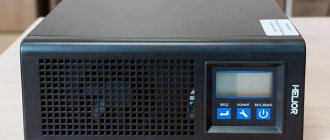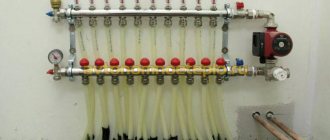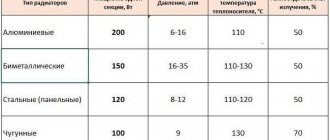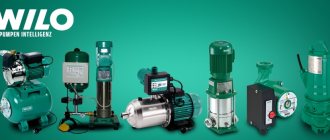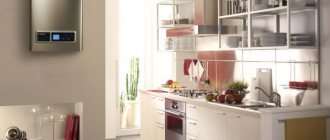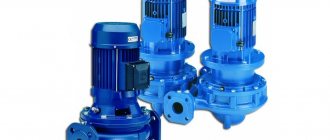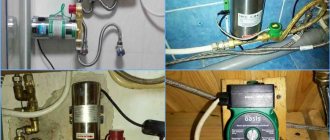Which Grundfos pumps are best for underfloor heating?
In order to choose the right Grundfos pump for pumping coolant in heated floors, it is necessary to take into account that the manufacturer has released several models of equipment specifically designed for this purpose
It is worth paying attention to the following modifications:
- Grundfos UPS circulation pumps for water floor heating are popular due to their low cost and good technical characteristics. The disadvantages include a mechanical change in the speed of the pump, lack of adaptation, depending on the actual consumption of thermal energy. For premises with an area of no more than 100 m², the optimal solution would be to purchase a model from the UPS 25-60 series.
Grundfos Alpha2 circulation electric pumps with an electronic control unit for the underfloor heating system, with frequency control of pressure in the water circuit. The regulator automatically adjusts the operation of the pumping equipment, changing the circulation intensity. As a result, power consumption drops almost by half, module efficiency increases and ease of use is ensured.
Depending on the chosen model, the cost of a Grundfos pump varies from 8 to 80 thousand rubles. The price is affected by performance, throughput, and type of control unit. The classification of pumps for underfloor heating includes the UPS series (UPSD, UPE, UPS Series 100 and 200) and Alfa, Alfa2, Magna.
How to properly connect a Grundfos pump to a heated floor system
The Grundfos module is mounted in a manifold for underfloor heating using special pipes. For convenience, the connectors are engraved with arrows indicating the installation direction. The first start of the module is performed only after the system is filled with coolant. Connection to the electrical network is made through the terminal box. The housing is installed strictly in a vertical position.
Grundfos pumping equipment is the optimal solution for multi-circuit heating systems. Technical parameters allow connection to solid fuel, liquid fuel and gas equipment.
Main types of problems
Timely maintenance of a pump or pumping station for any purpose is the key to its correct operation and the durability of the system as a whole. Repairing pumps in a specialized service center, for example, in Sergiev Posad, is initially an expensive pleasure. However, if you are familiar with the structure of the unit and understand the principles of its operation, it is quite possible to eliminate malfunctions on your own.
Design and principle of operation
The Grundfos model range is represented by all main categories of pumping equipment:
- borehole;
- sewer;
- centrifugal;
- circulation;
- multi-stage self-priming units.
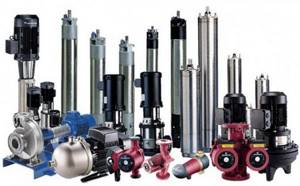
Borehole pumps are used in the water supply system and in the construction of wells with artesian water, for filling tanks and other water distribution systems. As a rule, these are deep installations operating in continuous or short-term mode, regulated by a pressure switch and a hydraulic tank. The product package includes three main elements - a motor, a built-in filter and an upper or lower water intake system. The products are represented by the SP, SQ and SQE equipment series.
Let's look at the design of Sololift sewer pumps, using the example of a typical Sololift 2 WC 3 unit. The installation consists of a tank equipped with inlet/outlet holes into which waste water flows. After preliminary cleaning provided by the filtration system, and upon reaching a certain level, which is monitored by the Grundfos level sensor, the pump turns on automatically. This starts the process of pumping the liquid into a centralized pipeline, septic tank or other disposal tank. The unit is also equipped with a shredder, which processes large household waste and prevents clogging of sewer pipes. The simplest installation is capable of raising water to a height of 5-7 m and transporting it 100 m in a horizontal plane.
Monoblock centrifugal pumps of the NB series are distinguished by a one-way suction system and are used in water supply, heating, ventilation, air conditioning and irrigation systems. Torque from the engine is transmitted to the rotor impeller, and liquid enters the central part of the unit. As the blades rotate, water or another carrier of thermal energy, in the case of a heating system, is thrown towards the external elements of the housing and redirected to the outlet pipe under the influence of centrifugal force. The pressure inside the system is regulated by a Grundfos level sensor.
Circulation pumps, represented by the UP, UPS, UPSD, Alpha 2 equipment series, are equipped with a wet rotor and are intended primarily to complete a closed-loop heating system. Its operation is based on centrifugal force generated by an impeller placed on the shaft. When water enters the central part of the rotating wheel from the suction pipe, it is thrown into the peripheral sections of the unit. The advantage of this series of equipment is the automatic cooling of the rotor, which rotates directly in the pumped medium. It is still recommended to entrust repairs to a circular heating pump with a wet rotor to professionals.
In the segment of self-priming equipment, the leader is Grundfos MQ 3-35, used in a pumping station with a membrane expansion tank. Water circulation is stimulated by an increase in pressure due to the centrifugal force generated when the impeller rotates. When it is forced out of the peripheral compartments of the installation into the pressure pipeline, the pressure in the central part of the impeller decreases and the liquid enters the pump housing. Such models are used to increase pressure and as part of clean water supply systems (drinking or technical).
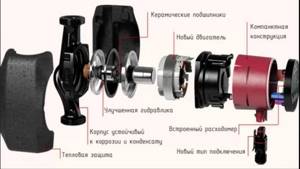
Grundfos circulation pump design
Common types of faults
Pump failure, as a rule, occurs suddenly and is caused mainly by incorrect operation, which also needs to be given a little attention. It is advisable to entrust the installation of Sololifts, for example, and similar high-performance equipment and the first switching on, to specialists.
Before connecting a submersible or surface pump to the electrical network or to a hydraulic accumulator, it is necessary to check whether there is liquid in the area where the intake device is located and in all pipelines of the system - during a “dry” start, the pumping station is almost 100% guaranteed to fail. The volume and temperature of pumping water must comply with the operating characteristics and manufacturer's recommendations.
When the pump is idle for a long time, for example, when used in a country house or in a non-residential country house, once a month it must be turned on for 15-30 minutes to prevent oxidation of moving parts.
Despite the differences in design and operating principle, most types of pumps are characterized by the following types of problems:
- lack of torque;
- premature spontaneous stoppage of work;
- increased noise level;
- increased vibration;
- insufficient pressure;
- stop after start.
Causes of problems
The absence of torque while the installation is humming indicates oxidation of the shaft as a result of long-term equipment downtime or contamination of the system with foreign insoluble or coarse elements in the composition of the pumped liquid. In both cases, cleaning can eliminate the malfunction; less often, measuring the rotor shaft or the entire engine is required. If the pump does not rotate or make noise when turned on, you need to check the power supply and voltage parameters.
When the pump randomly turns off a short time after starting, the problem is most likely caused by excessive deposits of lime and salt in the space between the rotor and the starter. The problem can also be solved by cleaning, which requires first turning off the system and dismantling the engine.
A high noise level when turned on indicates the presence of excess air in the pipelines, which can only be released while simultaneously increasing the inlet pressure. Sololift repair is not required in this case.
Grundfos sewer pumps
Grundfos Unilift KP 150-A1 – submersible drainage pump
The Grundfos Unilift KP 150-A1 pump is a drainage unit with a housing and working parts made of stainless steel. Equipped with strainer, check valve, handle, float switch and 10 meter cable.
Can be installed both stationary and mobile. Pumps relatively clean and slightly contaminated liquid with t ≤ +50 °C. Characteristics: flow rate 9.0 m3/h, head 5.25 m, immersion depth 10 m, power consumption 0.3 kW.
Pros:
- automatic operation: using a float;
- ease of use: small dimensions (15×22 cm), light weight (6.3 kg), low noise level (up to 65 dB), significant diameter of inclusions (10 mm);
- protection against idling, overheating and overload;
- corrosion resistance: the device is made of stainless steel;
- no need for maintenance;
- reliability and durability (10 years).
Minuses:
- Flimsy fastening of the filter using a clamp: it may fall off upon impact;
- relatively high price: 13.2-15.4 thousand rubles.
Grundfos SEG.40.09.2.1.502 – submersible sewage pump
Pump Grundfos SEG.40.09.2.1.502 – fecal unit with a cutting mechanism. With a power of 0.9 kW, it pumps out 15.0 m3/h of liquid with temperatures up to +40 °C. Capable of diving to 10 m and lifting drains to 14.5 m.
The design includes: cast iron body and motor connected by a clamp; adjustable impeller; horizontal flange outlet; stator temperature sensors. Automatically operates at a liquid depth of 0.25 m. Grinds particles Ø 10 mm.
Pros:
- huge productivity: 15.0 m3/h;
- corrosion resistance and reliability: durable stainless steel and cast iron are used;
- high efficiency: a chopper, an adjustable impeller, a cartridge shaft seal are available;
- automatic operation: a level relay is built into the design;
- overheating protection: temperature sensors are used;
- simple and easy procedures: settings, disassembly, assembly.
Minuses:
- large weight: 38.0 kg;
- very expensive: 66.4-72.5 thousand rubles.
Grundfos Sololift 2 C-3 – surface sewage installation
The Grundfos Solofit2 C-3 pump is a sewerage installation designed to connect 7 water intake points. Equipped with a plastic housing, dry motor, level switch, check and ventilation valves.
It works automatically depending on the depth of the liquid: at 65 mm it turns on, at 35 mm it turns off. Characteristics: flow rate 12.4 m3/h, head 8.5 m, power consumption 0.64 kW, wastewater temperature up to +90 °C.
Pros:
- automatic control using level relays;
- the presence of a cutting element and engine in a “dry” version;
- ease of installation: small size (width 16 cm) and light (6.6 kg); supplied assembled;
- high temperature of the pumped liquid: up to +60…+90 °C;
- no odors: ventilation with carbon filter;
- price corresponding to quality and performance characteristics: 19.9-24.4 thousand rubles.
Minuses:
- Over time, the float becomes clogged (sticks) and requires periodic cleaning;
- not for the toilet;
- noisiness.
How to choose a drainage pump for a private home and what to look for
If you have a country house, you know very well how many important issues need to be resolved to arrange it. One of them is the organization of wastewater disposal. A household drainage pump is necessary in a private home.
Drain waste from a washing machine, dishwasher and shower, remove water from a flooded basement, swimming pool or garden pond - a drainage pump for your home will do all this.
The ideal solution for domestic needs is an automatic drainage pump. The most common option is a submersible drainage pump with a built-in float.
If the water rises, the float mechanism turns on the pump; if the water goes down, it turns it off.
What drainage pumps can be used
Submersible drainage pumps differ in many ways - the material from which they are made; by the size of the particles they allow through; according to flow-pressure characteristics; on application and features of use.
The material from which the pump is made directly affects its reliability. Submersible drainage pumps can be made of composite materials in combination with stainless steel elements or made entirely of stainless steel.
For example, the Grundfos Unilift CC pump has a strainer made of stainless steel. The main parts of the pump, such as the coupling and housing, are made of molded composite materials.
All parts of the Unilift KP, Unilift AP (B) pumps in contact with water are made of stainless steel. Due to this, the pumps have high wear resistance. The size of the particles that a submersible sump pump filters is another important indicator.
Thus, Unilift CC and KP pumps work with small particles up to 10 mm in size. They are suitable for pumping relatively clean water, for example, from washing machines, washing units, showers, from rivers and ponds, flooded premises (we are not talking about pumping feces from sewers).
The Unilift AP (B) pump handles larger particles – up to 12, 35 or 50 mm, depending on the model. That is, it can pump dirty water with an increased content of sand/suspension.
For example, storm drains. When choosing drainage pumps for dirty water, find out exactly what fraction sizes and suspension compositions a particular model can handle.
Flow and pressure characteristics
The two main indicators that need to be assessed when choosing a drainage pump are flow and water pressure.
Typically, for domestic drainage applications, the characteristics of the Grundfos Unilift CC pump are quite sufficient: maximum flow rate - up to 14 cubic meters per hour, pressure - up to 9.5-10.9 cubic meters, depending on the size of the pump.
You can calculate the water supply like this. For example, we have a garage basement measuring 4x3x2 meters. We need the pump to be able to pump water out of the basement in case of flooding in no more than 4 hours.
- We calculate the volume of the basement: 4x3x2 = 24 m3.
- We determine the required flow: 24 m 3 : 4 h = 6 m 3 / h.
This means that you don’t need a pump with a flow rate of at least 6 m 3 /h. Calculating the pressure is also not difficult. Let's say the pump needs to be placed in a basement, which is 4 meters below ground level. The distance to the sewer is 30 meters.
We take into account that 1 meter vertically in this scheme corresponds to 10 meters horizontally. This means we need a pump that can lift water at least 7 meters: 4 + 30/10 = 7 m.
It is important to remember that the manufacturer indicates the maximum characteristics on the pump. For domestic use, the maximum pressure of the pump (it can be found on the nameplate of the pump) must be 2-3 meters greater than the calculated one.
According to our calculations, this is 9-10 meters. The Unilift CC 9 A1 pump is perfect for the given requirements. You can select a pump to suit your requirements using the Grundfos Product Center (GPC) equipment search and selection program.
The application and design features of the pump also largely determine the choice of model. Thus, the Unilift KP drainage pump is suitable for hot water.
It is made of stainless steel, can work with water heated up to 95 degrees and is suitable for short-term pumping of hot water. The Unilift CC pump can pump out water with a high air content better than others - it has an air vent built into its handle.
The same pump is well suited for pumping water from the floor to a level of 3 mm. To pump water with increased sand/suspension content, it is better to use the Unilift AP (B) pump.
Controlling the drain pump is easy
The drain pump control can be manual or automatic. Automatic, of course, is more convenient and reliable - if the pump operates without water, it may fail.
Typically, automatic sump pumps are equipped with a float switch. To control the drainage pump, simply set the desired on/off level.
The adjustment lever (the same float switch) is kept at water level. If it goes down, the pump automatically turns off. If it rises, it turns on.
A more complex drain pump is controlled through a special control cabinet. If you have decided on the type of drainage pump and are ready to make a purchase, professional advice will help you.
Grundfos sales engineer Ekaterina Semenova explains what you need to pay attention to when choosing a submersible drainage pump.
Quality and safety of execution. The submersible sump pump works with water and electricity. Therefore, the main point is the tightness of the cable entry. If the connection is not tight enough, an accident may occur.
Grundfos has additional protection on all drainage pumps - a special rubber layer that makes the connection as safe as possible.
Source: https://vse-o-kanalizacii.ru/drenazh/drenazhnyj-nasos-grundfos.html
Specifications
It is best to consider the characteristics of pumps using a specific example. A good option is the pump for the Grundfos heating system UPS 25-40 - a popular unit that is very often chosen by owners of country cottages. The numbers in the name mean that the device’s pipes have a diameter of 25 mm, and the pressure value is 40 dm (4 m). This pump is perfect for one-story houses, and when using single-pipe wiring, it can even cope with heating a two-story building.
The technical characteristics of the Grundfos heating pump are as follows:
- The pump can operate in three modes at a power of 25, 35 and 45 W;
- The volume of pumped liquid is 3.5 m3/h;
- The distance between the edges of the pipes is 18 cm;
- Device weight – 2.6 kg;
- Power supply from a regular 220 V power supply.
The body of the device is made of cast iron, and the engine is made of aluminum. The material used to make the impeller and bearings is ceramic, and steel was used to create the rotor. The selection of materials was not made at random - their combination made it possible to achieve high strength of the device and the ability to withstand high temperatures.
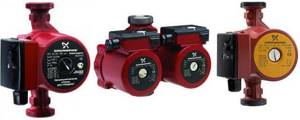
Particularly worth mentioning are ceramic bearings, the use of which turned out to be a very successful solution. Even under severe operating conditions, these elements can last more than 10 years without complaints. In addition, ceramics are quite beneficial in terms of reducing the noise level that the Grundfos heating pump creates during operation.
In addition to the already mentioned option, you can also find pumps on sale equipped with a technopolymer impeller and a ceramic rotor. Of course, such devices are much more expensive, but the high cost in this case has a direct connection with quality - thanks to the materials used, the efficiency of the design and its durability increase.
On any good pump, the manufacturer must put an arrow that indicates the direction of rotation of the rotor and the movement of the coolant. This arrow is made specifically so that the technician installing the pump does not mix up the pipes and install the pump backwards.
The device package usually does not include fastening elements, so they must be purchased separately. After installing the pump, you need to wait about a day before starting it. However, if the Grundfos circulation pump for heating was previously in a warm room for the specified period, then this rule can be neglected - the whole point is that the pump can only be used at positive temperatures, and it must first “get used to” them .
Differences between fecal and sump pumps
Sometimes fecal and drainage pumps are identified. Their functions are indeed similar, in some cases the devices are interchangeable and operate under similar conditions, but there are still differences.
If drainage models are equipped with mesh filters, then fecal models are equipped with special knives that cut through soft inclusions found in domestic and sewage drains.
Sewage pumps are not designed for pumping liquids with large solid contaminants, but they successfully cope with cutting plastic, paper, and thin tin.
In everyday life they are less practical than drainage ones. They are worth purchasing if you plan to use them for their intended purpose - for sewage.
Source: https://tehnova.ru/vodosnabzhenie/osobennosti-drenazhnogo-nasosa-grundfos-preimushhestva-i-harakteristiki.html
Features and benefits of pumps
The main advantages of Grundfos pumps are:
- The optimum ratio of price and quality,
- high energy efficiency of equipment,
- a huge selection that can satisfy any need.
- quite long service life,
- good technical support.
When choosing pumping equipment, the following technical parameters must be taken into account:
First you need to decide what type is needed. In total, there are three large groups: for wells, for heating, for drainage or sewerage. At Grundfos, designers have thought through in advance almost all possible problems that may arise in a particular area of operation. Therefore, when choosing equipment from this manufacturer, you get a unit that takes into account many years of experience.
Before ordering equipment, you need to decide what type of voltage will be used: single-phase or three-phase. For household pumps, single-phase pumps are mainly used; in industry, three-phase pumps are more commonly used.
The main characteristic when choosing a pump is the graph of pressure versus flow. This graph shows how much water the pump will pump depending on the required pressure. The higher the pressure that needs to be maintained, the less water the pump can pump. When choosing equipment, the required operating point must be under its curve. It is also necessary to provide a margin of 20% for the supply.
Power is also an important parameter. It depends on the current and voltage. This parameter is taken into account when selecting pump protection, as well as when calculating the required cross-section of power supply cables. The higher the power, the greater the productivity.
When choosing pumps, it is also necessary to take into account geometric parameters and connection dimensions
Before placing an order, you must make sure that the selected equipment is suitable both in weight and dimensions.
Depending on the operating conditions, it is necessary to pay attention to the minimum and maximum permissible temperature of the pumped medium. There are cases when the wrong choice of range led to equipment failure
Also, when choosing from equivalent pumps, you need to choose the one with a higher efficiency rating
In the long term, such equipment will provide significant energy savings.
In order for the unit to work for a long time and without interruptions, it must be installed correctly. Installation of any equipment must be carried out strictly according to the attached installation instructions. Also, do not forget about installing automated control systems for pumps.
Such a system will protect your unit from power surges, from engine overheating, from the possibility of working without water, from water getting inside, etc., and will also allow you to control the process automatically, without human intervention.
Another condition for durability is proper operation. It is also written in the instructions
It is important to understand that if a pump unit protection system is installed, then you need to be alert when it is triggered. It is best to carry out a full cycle of equipment inspection. https://www.youtube.com/embed/0_9CFtB_0RE
Advantages and disadvantages

The advantages of pumps from the Danish manufacturer include:
- high work efficiency;
- reliability of all components and parts;
- low level of own noise;
- versatility of application.
Grundfos pumps are used as part of heating systems and are in demand for organizing hot water supply (DHW) circuits. In addition, they can be installed in “warm floor” systems or in climate control equipment.
The versatility of Grundfos units is also evident in the fact that after purchasing them, the user will be able to work with the following types of coolants:
- water heated to a certain temperature;
- antifreeze that does not contain solid components;
- coolant with the addition of ethylene glycol in a volume of no more than 40 percent.
The advantages of equipment of this class include the operation of the rotor in direct contact with the coolant; it is separated from the other components by a metal cup made of stainless steel. In addition, in these models the inlet and outlet pipes are located at the same level, which ensures quiet operation of the entire unit. The significant advantages of products from the Danish manufacturer include:
- optimal ratio of declared price and quality;
- high energy efficiency indicators;
- a large selection of models capable of satisfying the most demanding customer;
- long service life and developed technical support system.
Characteristic disadvantages of Grundfos pumps are the relatively high price per unit of goods (from 6,500 rubles) and the absence of a cable for connecting to the electrical network.
Types of pumps
As for the variety of this type of pump, there are two most popular ones:
- Grundfos circulation pump for heating with a dry rotor. His photo is just below. Its peculiarity is that the motor practically does not touch the liquid it pumps. Often, such pumps are used in large systems where there is a need to pump large amounts of coolant;
- Glandless rotor pump. In such equipment, the rotor is located directly in the liquid. The main advantage of this design is that the air itself is removed when the pump starts.
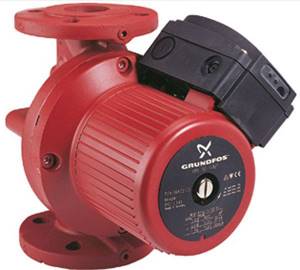
Dry rotor pump
Advantages of Grundfos pumps
The Grundfos heating circulation pump has the following advantages:
- Small power, but high performance. The height of the building never reduces the performance of the device, since the water supplied by the pump to the pipeline always pushes the coolant in the opposite direction;
- Minimal energy losses occur only due to friction in the pipeline;
- Significant energy savings. This is explained by the fact that the pump maintains the desired temperature in autonomous mode;
- All modern systems of this type are equipped with special temperature controllers. You can set the desired temperature on this sensor and then the system will maintain it itself. The pump can quickly adjust to the desired mode and maintain the already set temperature;
- Circulation pumps for Grundfos heating systems are characterized by a simple design. If desired, you can install such a unit yourself without the involvement of knowledgeable specialists;
- The buyer can select the appropriate pump for a specific system. It should be noted that the price will depend on the configuration of the device. All this allows the buyer to significantly save his own money;
- A huge plus is the practicality and reliability of circulation pumps. There are no unnecessary functions and parameters;
- Possibility of purchasing through the online catalog from an official dealer thanks to the provided photos and videos of pumps.

Installation process
Features of Grundfos pumps
The Danish company Grundfos is a leader in the design of high-quality pumping equipment. It covers half the needs of the entire world market. This company is trusted by millions of people, as it has successfully established itself in the sales market of circulation pumps and equipment of this type.
Special requirements are always put forward for the equipment of this company due to the fact that such systems must operate continuously and autonomously. Also, a huge advantage of Grundfos pumping units is high-quality warranty service.
Typically the warranty period is twenty-four months from the date of purchase. Instructions are included with all pumps.
An open heating system is the best choice for a country house - read about it here.
Varieties
Today the company produces two types of Grundfos circulation pumps:
- with dry rotor;
- with a wet rotor.
The first type is characterized by high performance pumping units. In addition, dry rotor pumps have high power. Such devices require a large amount of coolant, which is why these units are used mainly in industrial enterprises or in heating systems of large buildings. They are installed quite rarely in private homes.
The design feature is a rotor that does not come into contact with water, hence the name of the unit with a dry rotor. It is separated from the chamber where the coolant circulation process is carried out using a cuff.
The Grundfos heating circulation pump with a dry rotor makes noise during operation; it is equipped with a special fan, which is responsible for maintaining the desired temperature regime of the unit body.
For heating systems of private houses, the best option is the Grundfos UPS circulation pump. The abbreviation UP means that the device belongs to the category of circulation pumps, S is a three-speed switching system. In other words, such a pump can operate in three speed modes, which are switched either manually or automatically.
Comparing this type with devices with a dry rotor, it should be noted that circulation pumps with a wet rotor have a much lower efficiency, about 50%. But their advantage lies in their silent operation.
The main condition for high-quality operation is high quality coolant. If you follow it, the circulation pump can effectively serve for ten years or more.
For the heating system of the house, it is better to install a Grundfos circulation pump with automation. This way you can set the operating mode for several days. Secondly, such a device consumes less electrical energy. Thirdly, you don't have to maintain the pump. All you have to do is set the settings.
Selecting Equipment Based on Performance
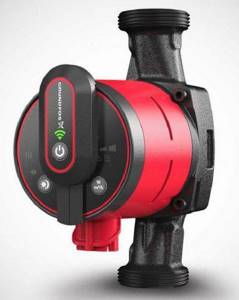
The performance of the device is the volume of pumped liquid, as well as the flow rate at the lowest load. The higher the performance, the better. To calculate this parameter there is a formula: Q = N / (t 2 - t 1). In it, the flow rate is designated by the letter Q. As for the temperature of the liquid in the pipes, it is designated t1, but the power of the heating source (in this case, the heating boiler is meant) is N. The supply temperature is t2. This value is determined after the heating boiler.
When the calculation is carried out, t1 should be equal to the limit from +60 to +70 °C, while t2 varies from +90 to +95 °C. This formula allows you to select approximate pump parameters. For 10 m of the length of the circulation ring, the equipment pressure will be required, which is 0.6 m minimum. Today, thermal standards are known: to warm up 10 m2, 1 kW of power is required. If we take the thermal power of the radiator section (200 W), then for every 10 m2 you will need 5 sections. You also need to take a small supply of 2 sections.
Calculation of the lower pressure limit - moment of switching on the NS
Any calibration begins from the very beginning - determining the minimum required pressure in the tap located at the highest point of the water supply system. For example, the required level in the taps on the 2nd floor of your house is 2 bars. However, remember that a pressure of 1 bar creates a column of water whose height is 10 m.
Of course, on the first floor the pressure will be higher. Calculate the height to which the water will rise from the accumulator to the extreme point of water intake. If the difference, suppose, is 8 m, then the pressure will be 0.8 bar. Then simple mathematics: add the required pressure on the second floor and the height of the water column, you get the minimum pressure in the pipes at the level of the accumulator. In our example it is 2.8 bar.
Next, you should determine the air pressure in the accumulator tank. It is good to use a tire pump with a pressure gauge for this. In this case, the container must be empty and the station disconnected from the network. Otherwise, it will be difficult to understand what total air and water pressure the relay is set to: a ratio of 2:1, or 1.5:1.5.
In accordance with the recommendations of the well-known manufacturer of pumping equipment Grundfos, the backpressure in the gas cavity must be at least 90% of the calculated minimum level. That is, if we take the example data, the indicator will be 2.8 x 0.9 = 2.52 bars. To achieve the desired value, it is necessary to bleed off excess air or, conversely, pump it up with an auto pump.
How to choose a Grundfos circulation pump
I would like to note right away that it is quite difficult to independently make calculations and select a pump that is optimally suited to an individual heating system. Company consultants and special online calculators can help you make your choice. As practice shows, the decision to purchase the model you like is most influenced by:
Technical characteristics of Grundfos circulation pumps - you should pay attention to power, throughput and type of design.
It’s a good idea to make sure that you are purchasing an original device and not a fake.
Design features.
Cost and service life of the module.
Circulation pumps for Grundfos heating systems are offered in five basic versions. Selection of equipment requires the involvement of a specialist. Below are recommendations from professional installation teams and consultants.
How to distinguish a fake pump from an original Grundfos
Malfunctions of the Grundfos circulation pump are excluded if the original module is purchased. All breakdowns are mainly due to fakes. To avoid purchasing a low-quality surrogate, you should follow the following rules:
- You can purchase the model you like only in the official store of the company.
All products are certified and have permission from Rostechnadzor, as evidenced by the documentation provided in the kit. The original pumps have instructions in literate Russian.
Dimensions – it’s easy to distinguish a fake by using a ruler. Original products have an installation length of 18 cm. As a rule, the body of surrogates is 13 cm.
The speed switch in a mechanical pump is non-removable. The body is painted evenly and with high quality.
The pump consists of a rotor, stator, stainless sleeve, bearings. A specialist will be able to notice the differences.
Low cost. Factory products from a German brand cannot be cheap. As a rule, a counterfeit product is 2 times or more cheaper than the original.
How to calculate the required power of a Grundfos pump
The selection of a circulation pump is carried out according to several parameters:
- Heated area.
Throughput and height of the water column.
The choice of heating area is carried out in the following way:
- Determine the boiler performance. So, for a room of 200-250 m², you will need a 25 kW boiler.
It is believed that the throughput of the boiler per minute is equal to its productivity. Accordingly, a 25 kW boiler passes through itself 25 liters of coolant per minute or 1500 l/hour.
The pump is selected according to these parameters.
To facilitate the choice, the technical documentation of the pumping equipment immediately provides approximate parameters of the heated area.
Cost of Grundfos pumps
The average cost per unit of pumping equipment varies from 5 to 80 thousand rubles. The cost of the model is influenced by several factors:
- Technical characteristics of circulation pumps for heating of the Grundfos brand. Performance, the presence of a twin electric motor, and an automatic control unit - all this increases the cost of the model.
Additional equipment. After connecting the pump, the heating system becomes volatile and stops working after a power outage. To eliminate this drawback, you will need to connect an uninterruptible power supply. Installation to heated floors is carried out using a special mixing unit.
The high cost is justified when you consider that maintenance of circulation pumps for Grundfos heating systems is not required. The models will work throughout their entire service life without any complaints and will help to significantly save on electricity.
Service life of Grundfos pumps
The average service life of pumps is 7-9 years. Most models are covered by a 3-year factory warranty. Several factors directly influence the service life:
- Correct installation of the heating pump.
Coolant quality - it is allowed to use glycol-containing compounds with a maximum permissible antifreeze content of no more than 30%, in relation to the total volume. Water must be purified from impurities.
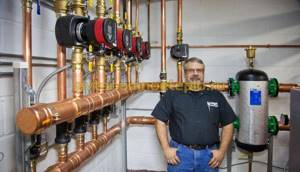
Date: September 25, 2021
What is a BP/BP connection?
The detachable connection BP/BP of the heating system is a set of adapters that allows you to connect the pipe to the pump body.
- BP/BP means nut/nut;
- BP/HP means nut/thread.
BP/BP adapters are used to connect circulation pumps. Here is an example: Photo of an adapter for connecting a BP/BP pump (1 1/2″ - 1″). This means that the pump nut has a diameter of one and a half inches (32 mm), and the pipe connection nut has an inch (25 mm) diameter.
On the nameplate of the pump and in its description, the diameter G is often indicated; this is the diameter of the union nut for the pump. Pumps are sold complete with connection adapters.
Note: Threaded connection of circulation pumps is typical for low-power household pumps. More powerful pumps are connected via flange connections.
Stages and rules of repair
Repair of the Sololift pump, as well as repair of a Grundfos pumping station for any purpose, can be done independently, having first identified the source of the problem.
Equipment diagnostics involves several stages:
- start the pumping station, assess the noise and vibration levels;
- check the pressure indicators;
- make sure that the motor does not overheat during operation;
- check the presence and quality of lubrication of node connections;
- make sure the integrity of the structure and the absence of leaks;
- inspect the box for secure fixation of the terminals.
If you are sure that the malfunctions are not caused by lime deposits and contamination, overloads or operation at maximum power, the pump can be disassembled. When planning to repair the Grundfos pump yourself, make sure that the water is drained from the pipelines and turn off the system. Disassembly begins with the junction box and visual assessment of components. As a rule, such an inspection makes it possible to immediately detect a burnt out or worn out part. If not, we will continue to disassemble the installation.
The engine must be in a vertical position during disassembly . This will prevent the risk of oil leakage. To diagnose the starting mechanism, you must connect an ohmmeter to the engine. This instrument, when rotating the handle, generates a voltage in the range of 200-300 V, sufficient to take readings on a resistance meter. Diagnostic data that is too high, reaching infinity, indicates a break in the working phase, too low - an interturn short circuit. Independent adjustment of operating parameters with such deviations is impossible.
Grundfos circulation pump: repair review (video)

Circulation pumps have proven themselves to be excellent in heating systems. Structurally, the pump has a very similar structure to the pump design. As a rule, the casing of pumping equipment is made of fairly strong and corrosion-resistant materials (brass, bronze, cast iron, stainless steel). This material is able to interact well with both aggressive environments and high temperatures.
Let's understand the device
Since the device is in constant contact with water, its body is usually bronze or stainless steel - this avoids corrosion.
It is connected to the heating system via a threaded or flange connection. The Grundfos pump for the heating system is produced as a single device, including an electric motor and a control unit.
The rotor, which is immersed in the liquid, is separated from the stator and placed inside a stainless steel glass.
Some models are equipped with an air valve. Air congestion will be a thing of the past. Some pumps can be equipped with a heat-insulating screen that reduces heat loss.
Before purchasing this equipment, you should decide what parameters are needed for the efficient operation of the heating system. The following characteristics must be taken into account:
- liquid temperature;
- hydraulic resistance size;
- cross-section of pipes that will be connected to the unit;
- heat demand of the house.
Based on the specified parameters, power is calculated. It is able to minimize hydraulic losses, thanks to which the system will warm up evenly and even in severe frosts provide high-quality heating of the house.
You should know that the selection of a circulation pump for a Grundfos heating system requires that you focus on characteristics such as:
- productivity, that is, the volume of liquid pumped by the device per hour of operation (it depends on the hydraulic resistance in the system);
- pressure - the greatest height to which it is capable of raising a column of water;
- maximum coolant temperature - it is better to choose a device that can pass liquid heated to 110 degrees C;
- the diameter of the heating system pipes (usually 32 or 25 mm), as well as the dimensions of the device body so that it fits in the intended place;
- amount of energy consumed;
- noise level.
Let's sum it up
You should not choose a pump with a power reserve, since it will run idle for a long time. And this will increase energy consumption.
A correctly selected circulation pump works with optimal efficiency.
As a result, the entire heating system functions as efficiently as possible, providing your home with the necessary heat, while consuming a minimum of electricity. Automatic elements included in some models extend their service life and improve the quality of heating.



